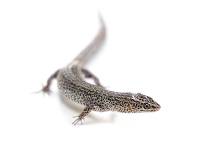Josh's Frogs
Desert Night Lizard (Xantusia vigilis) Care Sheet

By Will Gyurgyik
NAME
Xantusia vigilis is commonly known as the desert night lizard. Despite the name, this species is actually diurnal (active during the day)! The name likely derives from their very secretive nature, although they acclimate well and become fairly bold in captivity.
COLORATION
Desert night lizards range from gray to beige and even olive. These lizards have dark mottling and spotting along their body.
HOUSING
Although small, this active species enjoys space to move around. A minimum12x12x12 enclosure will house a lone animal or pair, but an 18x18x12 or 10 gallon enclosure is recommended for more individuals. Juveniles can coexist in groups and with their parents, but adults should only be housed in pairs. Sand works well as a substrate. Typically, this species takes advantage of both horizontal and vertical space, so climbing material is recommended. We very strongly encourage the use of cholla wood, which provides both climbing material and hiding places. Hides on the ground, such as stacked slate, will also work. While these lizards do not often dig, heavy items should be supported by the bottom of the enclosure area rather than the substrate.
TEMPERATURE
Keep desert night lizards around 75-85 F. Use a basking bulb to provide a basking spot of around 95 F. Being diurnal, this species also requires UVB light. Mercury vapor and metal halide bulbs are often too hot and too wide for a smaller desert setup, so we recommend using a dual light fixture, which works very well for small enclosures in providing both heat (via a mini halogen bulb) and UVB (via a compact fluorescent bulb). Temperature should be monitored with a digital thermometer. The basking spot can be checked with an infrared thermometer or temperature gun. Night temperatures can safely drop down to 68 F.
HUMIDITY
Keep desert night lizards at 40-50% humidity. A humid hide is recommended. This can be as simple as keeping moist sphagnum moss at the base of a piece of cholla wood or underneath a hide. Ambient humidity should be monitored with a digital hygrometer. Mist the habitat around three times a week to provide dew on enclosure walls and cage items from which they can drink, although enough ventilation should be provided to allow the enclosure to dry out within a few hours. A shallow water dish can be provided but is not necessary with regular misting.
SIZE
Desert night lizards are born at close to an inch in size. As adults, they will only reach around 4 inches in length!
DIET
Desert night lizards are insectivores. They should be fed a varied diet of appropriately sized insects, including crickets, fruit flies, and bean beetles. All feeder insects should be gut loaded and dusted with vitamin/mineral supplements. A food dish may be used but is unnecessary. These lizards are active and will actively chase after moving prey.
SEX
This species is not sexually dimorphic and can be difficult to sex. However, they may be sexed with some accuracy by candling (passing a bright light through) the base of their tail: whereas females will not show any organs, adult males will exhibit a pair of hemipenes through the light.


BREEDING
We have successfully bred the Desert Night Lizard without brumation. However, a cooling period or changes in day-night cycle throughout the year will likely help to incite breeding. Females are viviparous (live bearers), birthing a litter of 1-3 lizards once a year.
CONCLUSION
This lizard is a unique desert species that exhibits fascinating behavior. Their haardiness and small size make them great pets!
Links of Interest:
https://animaldiversity.org/accounts/Xantusia_vigilis/classification/

